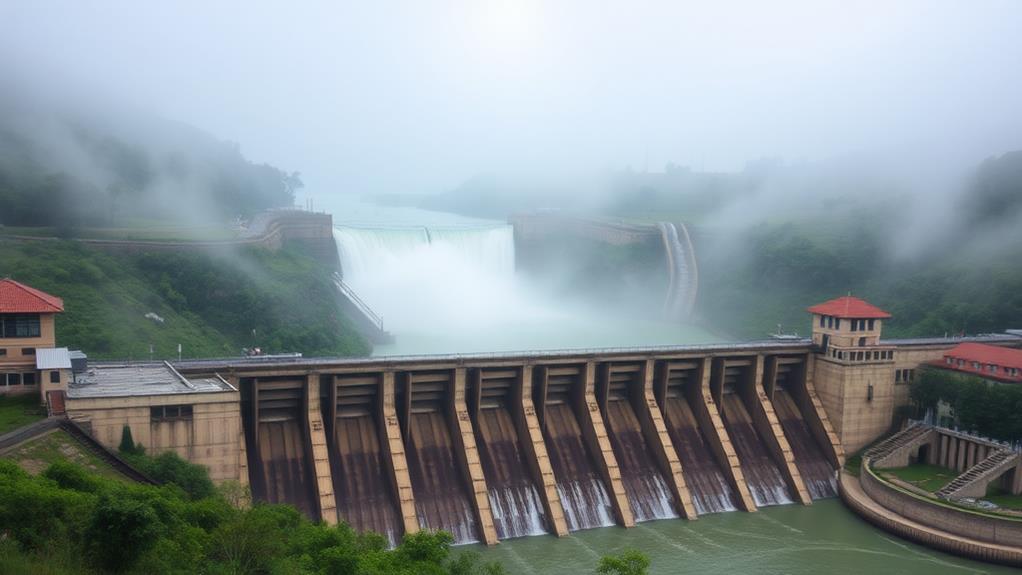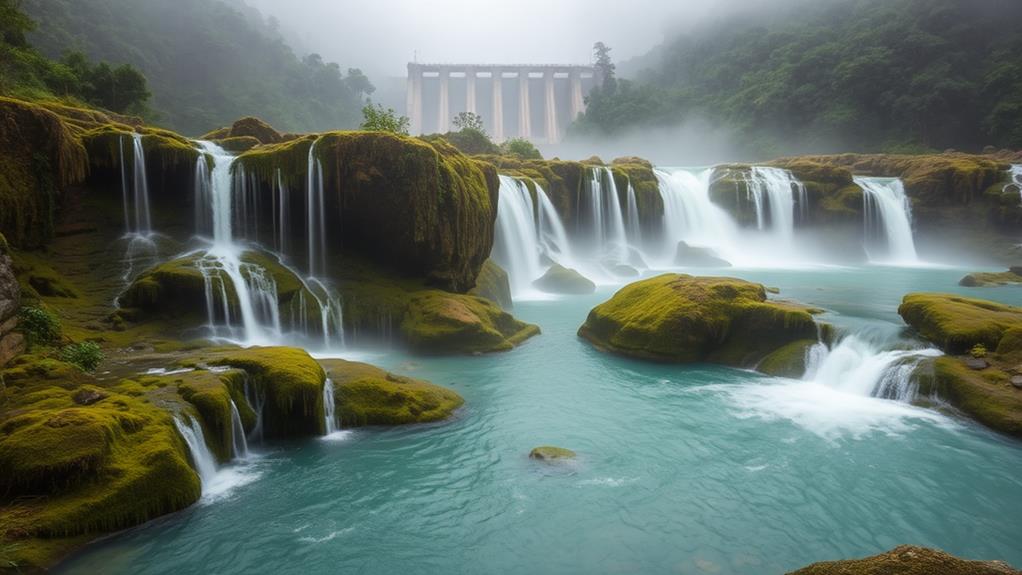Maria Cristina Falls: Harnessing the Power of Water for Energy
The Agus VI Hydroelectric Plant generates 200 megawatts of power. This significant amount of energy meets 70% of Northern Mindanao's electricity needs.
The plant achieves this remarkable feat through a unique setup of two power stations and eight turbines, utilizing the kinetic energy from the Agus River.
The plant implements eco-friendly practices. This includes monitoring water quality and promoting conservation.
By doing so, the facility is paving the way for a renewable energy future.
The Power of Hydroelectricity

Harnessing Hydroelectric Power for a Sustainable Future
Hydroelectricity is a crucial component of renewable energy, and the Agus VI Hydroelectric Plant in Maria Cristina Falls is a prime example of its potential. This plant supplies around 70% of Northern Mindanao's electricity, reducing reliance on fossil fuels and contributing significantly to sustainable energy.
The plant's eight turbines convert the kinetic energy of water flowing at an average rate of 130 cubic meters per second into electrical energy. With a potential generating capacity of 200 megawatts, the plant has undergone renovations, such as the 2014 enhancement, to increase its generating capacity and efficiency in energy production.
Future expansion plans aim to increase the generating capacity to approximately 417.1 megawatts, aligning with the Philippines' national renewable energy targets.
Balancing Energy and Environment
Achieving Sustainable Energy in Northern Mindanao
The Agus VI Hydroelectric Plant in Maria Cristina Falls generates 70% of Northern Mindanao's electricity, making significant strides towards sustainable energy.
This achievement is remarkable considering the plant's commitment to environmental preservation.
Balancing Energy Generation with Environmental Preservation
To minimize ecological disruption, the Maria Cristina Falls hydroelectric power plant implements sustainable development policies.
These measures include:
1. Hydrological devices to monitor water quality, mitigating the environmental impact of the power generation process.
2. Eco-friendly tourism initiatives, such as the National Power Corporation Natures Park, promoting eco-tourism while preserving the surrounding flora and fauna.
3. Continuous improvement, as seen in the 2014 renovations that enhanced the plant's generating capacity to 200 megawatts, reflecting a commitment to increasing renewable energy production without compromising environmental health.
Commitment to Ecological Sustainability
These efforts demonstrate the Philippines' dedication to diversifying energy sources while prioritizing ecological sustainability.
The country aims to generate approximately 417.1 megawatts in future expansion plans, showcasing its commitment to renewable energy and environmental preservation.
Engineering Feats and Innovations

The Maria Cristina Falls' hydroelectric power plant is a remarkable example of innovative design. This plant consists of two power stations at different altitudes, utilizing eight turbines to convert the significant kinetic energy from the falls into electricity.
This unique setup enables the plant to harness the power of the Agus River, generating a substantial amount of electricity for Mindanao, Philippines.
The 2014 renovation efforts significantly enhanced the generating capacity of the Agus VI Hydroelectric Plant. The upgrade increased the plant's capacity to 200 megawatts, improving both stability and efficiency in renewable energy production.
The average flow rate of 130 cubic meters per second at the falls supports the substantial power generation capabilities of the hydroelectric facility.
The plant's commitment to energy diversification and sustainability is evident in its future expansion plans. These plans aim to increase the power generation capacity to approximately 417.1 MW, solidifying the plant's position as a leader in hydroelectric power generation.
Preserving Nature's Beauty
The management of Maria Cristina Falls recognizes the importance of preserving the natural beauty surrounding the facility while harnessing its energy potential. This commitment to environmental preservation is evident in the National Power Corporation's Natures Park, which promotes eco-tourism and supports conservation efforts in the surrounding environment.
Hydrological monitoring is crucial to minimize the ecological impact of the hydroelectric plant. Devices are employed to monitor water quality, ensuring the Agus River and its biodiversity are protected.
The management of the hydroelectric facility follows sustainable development policies to protect local ecosystems and preserve the surrounding flora and fauna.
Maria Cristina Falls serves as a dual attraction, offering both a renewable energy source and a stunning natural landscape. This fosters a commitment to a sustainable tourism model, promoting eco-friendly practices and responsible travel.
Sustainable Energy for the Future

The Agus VI Hydroelectric Plant: A Beacon of Sustainable Energy Production
The Agus VI Hydroelectric Plant harnesses the power of Maria Cristina Falls to generate 200 megawatts of electricity, which supplies approximately 70% of Northern Mindanao's power needs. This is achieved through the operation of eight turbines and a water flow rate of about 130 cubic meters per second, effectively harnessing the kinetic energy of the falls for electricity generation.
Renovation and Efficiency Improvements
A renovation in 2014 improved the plant's stability and efficiency, contributing to a significant reduction in greenhouse gas emissions and a smaller local carbon footprint.
Future Expansion and Sustainability
Looking ahead, plans are underway to expand the generating capacity of the plant to around 417.1 megawatts, aligning with the Philippines' commitment to energy diversification and renewable energy targets.
This won't only support local economies through job creation but also promote sustainable development and ecological preservation in the region.
The hydroelectric power produced at Maria Cristina Falls is a shining example of how renewable energy can drive sustainable development, and its continued operation will play a vital role in shaping a greener future for generations to come.
How Does Sustainable Forest Management Impact the Use of Water for Energy at Maria Cristina Falls?
Sustainable forest management balance economic ecological impact water for energy use at Maria Cristina Falls. By managing the forest in a sustainable way, it helps protect the watershed, ensuring a consistent supply of water for energy generation. This approach supports both economic development and ecological conservation.
Harnessing Water's Potential
Maria Cristina Falls is a natural wonder that harnesses the potential of water for energy generation. Maria Cristina Falls, located in Iligan City, Philippines, is a breathtaking 320-foot waterfall that has been utilized for hydroelectric power since 1955. With the growing demand for sustainable energy sources, the falls serve as an important source of renewable energy in the region. Harnessing the power of Maria Cristina Falls contributes to building resilience in natural resource sectors, as it reduces dependence on non-renewable energy sources and helps maintain a balance between human needs and environmental conservation. Additionally, the falls play a significant role in promoting the country’s commitment to reducing greenhouse gas emissions and combating climate change.
Hydroelectric power generation is a significant way the falls are utilized. The Agus VI Hydroelectric Plant, powered by the falls, has a potential capacity of 200 megawatts and supplies approximately 70% of Northern Mindanao's electricity.
The plant's efficient turbine integration is key to its success. The integration of eight turbines allows for effective harnessing of water's potential, contributing to the region's renewable energy goals.
Future expansion plans aim to boost the generating capacity of the plant to approximately 417.1 megawatts, aligning with the Philippines' commitment to energy diversification and sustainability.
Frequently Asked Questions
What Is the Source of Energy for Maria Cristina Falls?
The source of energy for Maria Cristina Falls is its hydroelectric power potential.
This potential is generated by the falls' kinetic energy, which is produced by an average water flow of 130 cubic meters per second. By harnessing this energy, electricity is produced, and this renewable energy source has a minimal environmental impact on the local ecosystem.
This renewable energy source allows the region to reduce its reliance on non-renewable energy sources, supporting a cleaner, more sustainable future.
What Is the Significance of Maria Cristina Falls?
Maria Cristina Falls holds significant importance as a tourist attraction, showcasing the region's natural beauty with its breathtaking scenery and picturesque surroundings. This natural wonder draws visitors from around the world, promoting eco-tourism and encouraging the preservation of the environment.
The falls have a positive environmental impact by reducing greenhouse gas emissions through the generation of hydroelectric power. This renewable energy source helps minimize the region's carbon footprint, contributing to a cleaner and healthier environment.
As a cultural heritage site, Maria Cristina Falls preserves the region's history and identity. The falls have been an integral part of the local culture for centuries, with many indigenous communities considering them a sacred site.
The preservation of the falls ensures the protection of the region's cultural heritage for future generations.
The falls support the local economy by generating jobs and fostering business growth. The tourism industry surrounding the falls creates employment opportunities, stimulates local trade, and contributes to the overall economic development of the region.
What Is Harnessing the Power of Water?
Harnessing the power of water involves converting the kinetic energy of flowing or falling water into electricity. This is often done through hydroelectric power plants, which reduce reliance on fossil fuels and minimize ecological impact and greenhouse gas emissions.
Hydroelectric power is a renewable resource that supports a sustainable future with a smaller carbon footprint.
Hydroelectric power plants work by channeling water from a higher elevation to a lower elevation, using the force of gravity to drive turbines connected to generators. These generators then produce electricity, which is sent to the power grid and distributed to homes and businesses.
The benefits of hydroelectric power include its clean and efficient nature, making it a vital component of our transition to renewable resources.
What Is Energy Known as Is Generated by Harnessing the Power of Falling Water?
Energy generated by harnessing the power of falling water is known as hydroelectric power. This renewable energy source reduces environmental impact by minimizing greenhouse gas emissions.
Hydroelectric power plants convert kinetic energy from flowing water into electricity, contributing to water conservation efforts.
For example, the hydroelectric power plant at Maria Cristina Falls plays a crucial role in providing a sustainable alternative to fossil fuels, making it a vital component of a renewable energy strategy.